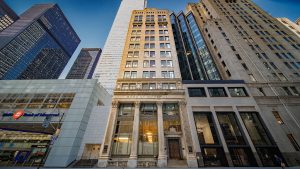A team of five Toronto scholars won top honours against the best urban planning students in North America this spring, winning the Urban Land Institute’s Hines Competition for students and pocketing $50,000 for their efforts.
The champions, tops out of 105 competitors from 61 different campuses, consisted of Frances Grout-Brown and Leorah Klein of Ryerson University, Yanlin Zhou of York University and Ruotian Tan and Chenyi Xu of the University of Toronto.
The Canadians were crowned in April for their master plan to redesign an urban space in downtown Kansas City that combined the twin themes of connectivity and resilience.
Grout-Brown and Klein said in a recent Zoom interview the team excelled in creativity, collaboration, communication skills and graphic presentation.
“I think we built a really, really good relationship,” said Klein. “As our team leader Frances did a really good job of setting a really strong working schedule and making sure that everyone was on track. I think that really helped in all the dynamics when things can kind of slip.”
Grout-Brown just graduated from Ryerson’s master planning program and Klein recently wrapped up her masters in urban planning. Zhou is in real estate finance and infrastructure; Xu is in architecture and Tan is an urban designer.
The team’s master plan for linking Kansas City’s East Village, Paseo West and downtown core features affordable mixed-use development, with active transportation encouraged to help reconnect surrounding districts to the downtown. The plan includes east-west transit corridors lined with protected bike lanes, dedicated bus lanes, and expanded boulevards and streetscapes.
Other features include a food incubator that promotes food sustainability and encourages local entrepreneurship, community gardens, and a new stormwater management system that would use green infrastructure to absorb runoff naturally.
“What really grabbed us initially was the fact you have a 16-acre site in the middle of downtown that is well served by transit, with the ability to create a livable and walkable neighbourhood,” Grout-Brown said. “That was the direction that we decided to take it. I think there were other submissions that focused more on creating a draw for visitors to stadiums and stuff like that.”
Grout-Brown said the themes of sustainability and connectivity are strongly evident in their home base of Toronto, so it was natural for those values to be included in the project plan.
“I think that each of us really wanted to be able to achieve those values of affordability, sustainability, economic resilience and inclusivity and really figure out what are the design elements that can allow us to achieve those goals,” she said.
Klein said there was lots of public transit in the vicinity but the team identified an opportunity to boost active transportation.
“We put a protected bike lane going over the highway loop so that it’s easy for people within maybe a 10-minute, 15-minute radius to bike safely downtown and come to the site, so it was definitely one of our strategies to better connect inside and outside of our sites,” she explained.
In the finals, Klein said, their presentation used superb visuals developed by Tan and Xu to show the judges what it would be like for citizens to experience the space.
“They’re so talented,” she said.
Klein and Grout-Brown have already moved into new jobs, with Klein — who put her share of the prize money mainly towards rent — noting that the Hines competition experience confirmed for her that her chosen field of development could be a powerful vehicle for city-building.
“You can make something really wonderful, inclusive and sustainable, and really thoughtful buildings and communities, and so it was important for me to seek out developers that have values that align with my values,” she said of her career search.
Faculty advisers for the team were Steven Webber and Victor Perez-Amado, both assistant professors at Ryerson’s School of Urban and Regional Planning. Professional advisers were Raymond Lee, senior associate with Weston Williamson + Partners, and Christina Giannone, vice-president, planning and development with Port Credit West Village Partners.
Follow the author on Twitter @DonWall_DCN.











Recent Comments
comments for this post are closed